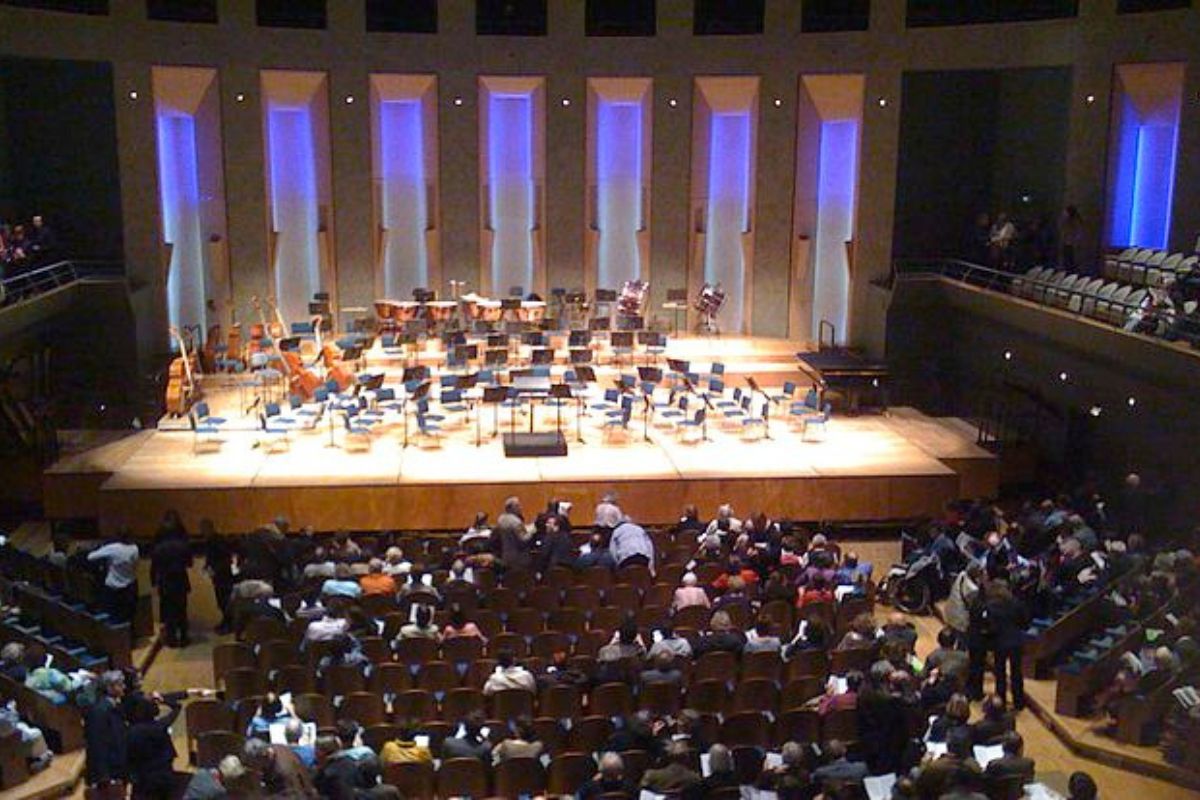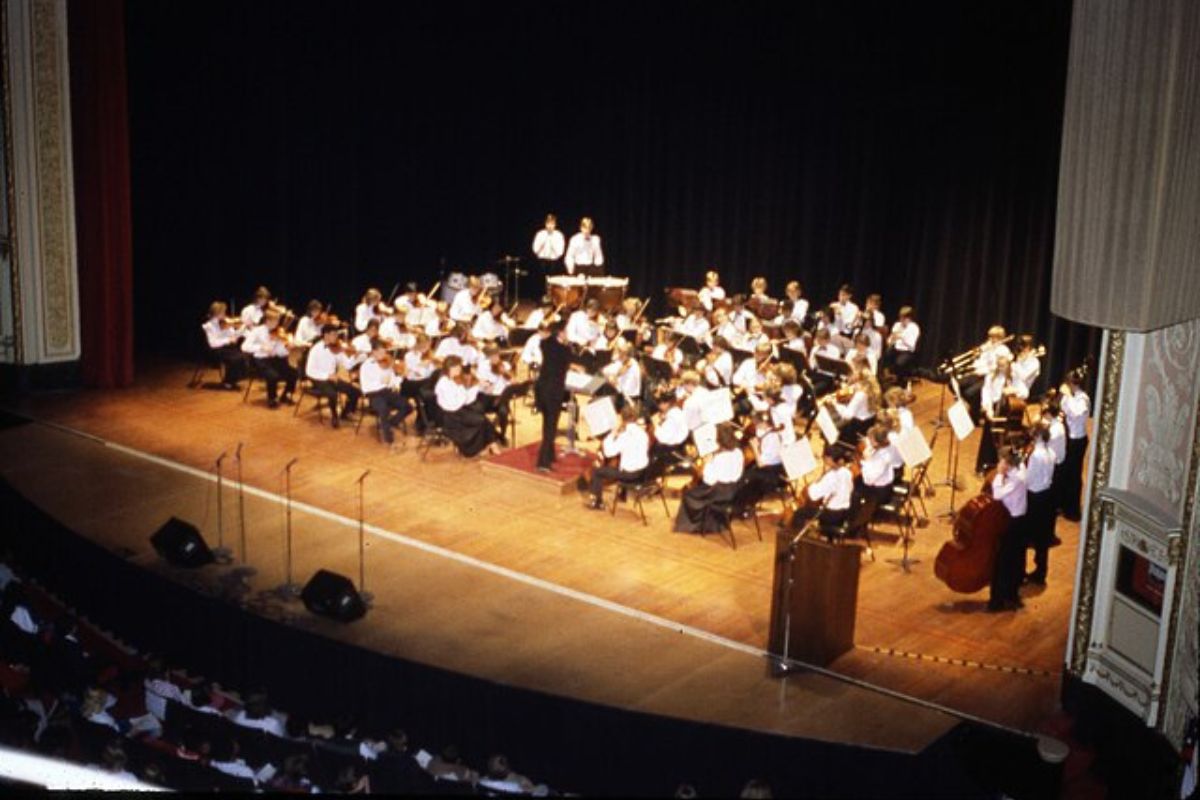Consider painting a vivid picture using only musical sounds and no words. That is the magic of program symphony at work. It’s like an immersive audio experience, transcending linguistic barriers and leaving everything to the powerful magic of sound and rhythm.
What is a program symphony? It’s an instrumental genre composed to narrate a story or paint a mental image. Traditional norms don’t hold much weight; rather, the rhythm of movements is largely influenced by the story’s essence.
How’s a program symphony structured?
A program symphony is structured around a narrative or descriptive idea, and its organization can vary based on the story or concept being portrayed. Common elements of its structure include:

- Thematic material: Distinct musical themes or motifs represent specific characters, emotions, or events.
- Movements: Program symphonies often have multiple movements, each depicting a different part or episode of the narrative.
- Descriptive titles: The movements might be named or given descriptors to hint at their narrative content.
- Dynamic variations: Changes in volume and tempo to emphasize different moments or emotional shifts within the narrative.
- Instrumental color: Different instruments or orchestral sections may symbolize various characters or moods within the story.
- Written program: An accompanying narrative or description that guides the listener through the musical journey and provides context for the themes and motifs.
Continuously learn from your experiences, other composers, and new music techniques to grow and refine your craft.
AKAI Professional MPK Mini MK3

AKAI Professional MPK Mini MK3
Is program symphony appropriate for a home studio?
You’re golden with the right digital audio workstation (DAW) and some creativity. Carve out the storyline in your mind and let your instruments do the talking.
For the classical context, whether it’s suitable for a home studio would depend on what you’re aiming to achieve. Like a home studio, recording a full symphony would require significant space and equipment. However, recreating or analyzing a program symphony using digital software is feasible in a home studio.
What makes a program symphony unique?
A program symphony stands out in the realm of classical music due to several defining characteristics:
- Narrative structure: Unlike traditional symphonies, a program symphony tells a specific story or depicts a sequence of events through music.
- Descriptive titles: Movement within the symphony often indicates the narrative or mood portrayed.
- Thematic development: Uses recurring themes or motifs to represent characters, ideas, or emotions throughout the piece.
- Instrumentation: Often features specific instruments or unique orchestration to depict particular scenes, characters, or emotions.
- Integration of outside elements: This may include external texts, poems, or program notes to provide context or clarity to the narrative.
- Expressive techniques: Emphasizes emotional expressivity and can use unconventional compositional techniques to convey the story.
- Evocative atmosphere: Often creates vivid atmospheres, landscapes, or scenarios, allowing listeners to visualize or feel the narrative.
In essence, what makes a program symphony unique is its intentional fusion of music with narrative storytelling, turning the orchestral performance into a sonic depiction of a tale or concept.
What musical components are adjustable in a program symphony?
In a program symphony, like in other orchestral compositions, various musical components can be adjusted to convey the intended narrative or emotive content. Here are the adjustable musical components in a program symphony:
- Themes and motifs: The primary melodies or short musical ideas that represent characters, emotions, or specific events in the narrative.
- Instrumentation: Choice of instruments and adding or omitting certain orchestra sections to produce desired colors or effects.
- Dynamics: Levels of loudness or softness can be varied to evoke different emotional responses.
- Tempo: The speed of the music can shift to reflect the pacing of the narrative or emotional intensity.
- Harmony: The choice and progression of chords can create tension and resolution or paint specific atmospheres.
- Rhythmic patterns: Rhythmic variations can depict action, create urgency, or convey calmness, among other effects.
- Texture: Layers of musical lines can be thick (with many voices) or thin (with fewer voices), impacting a passage’s overall feel and weight.
- Form and structure: While adhering to some conventional structures, a program symphony might deviate or introduce unconventional forms to suit the narrative.
- Expressive techniques: These include techniques like rubato (flexible tempo), portamento (sliding between notes), or specific bowing techniques for string instruments to convey particular moods or effects.
- Descriptive titles: Titles for the movements or sections that provide insight into the narrative or emotive content of that part of the symphony.
By adjusting these musical components, composers can convey the specific storyline, emotional journey, or pictorial content they intend in a program symphony.

Can I compose my own program symphony?
Absolutely! Anyone interested in music composition and a story or concept they want to convey can compose their own program symphony. Here’s a brief overview of how you can approach this:
- Conceptualize your narrative: Decide on the story or theme you want to convey. This could be based on personal experiences, historical events, legends, or abstract concepts.
- Choose your instrumentation: Determine the instruments you want to use. Different instruments can evoke emotions or represent various characters or elements within your story.
- Develop themes and motifs: Create distinct melodies or rhythms that can symbolize characters, emotions, or pivotal events in your narrative.
- Structure your symphony: Decide on the number of movements and their order. Each movement can represent a chapter or segment of your story.
- Experiment with musical elements: Play around with tempo, dynamics, harmony, and other musical components to enhance the emotional and narrative depth of your symphony.
- Notate your composition: Use music notation software or traditional manuscript paper to notate your work. This helps in sharing, revising, and performing your composition.
- Seek feedback: Share your composition with mentors, peers, or music enthusiasts to gather feedback. This can offer valuable insights and help refine your work.
- Perform or record: Once satisfied, you can organize a performance or record your symphony. Today’s technology allows virtual orchestras and digital audio workstations (DAWs) to produce realistic symphonic recordings even if you don’t have access to a live orchestra.
- Continue learning and refining: Composition is a lifelong journey. Continuously learn from your experiences, other composers, and new music techniques to grow and refine your craft.
What are the advantages and disadvantages of creating a program symphony in a home studio?
Creating a program symphony in a home studio offers flexibility, cost-effectiveness, and a personal comfort zone; however, it may also present disadvantages such as limited acoustics, the potential for distractions, and a lack of access to professional-grade equipment and spaces.
Advantages of creating a program symphony in a home studio:
- Cost-effective: Compared to renting a professional studio or hiring an orchestra, producing in a home studio can be much more affordable.
- Flexibility: You can work on your composition anytime without being restricted to studio booking hours.
- Comfort and familiarity: Working in a familiar environment can be less intimidating and more conducive to creativity.
- Technological advancements: Modern Digital Audio Workstations (DAWs) and virtual instrument libraries can convincingly emulate the sound of a full orchestra.
- Iterative process: Easy to revisit and tweak compositions over time without incurring extra costs.
- Total creative control: No external pressures; you can take your composition in any direction.
- Learning opportunity: Managing the entire process can be a significant learning experience, from composition to production and mixing.
Disadvantages of creating a program symphony in a home studio:
- Limited equipment: Home studios might not have high-end equipment available in professional studios, which can affect sound quality.
- Space constraints: Limited space can impact acoustics and restrict the ability to record live instruments.
- Lack of live orchestra: While the software has come a long way, there’s a unique richness and depth to a live orchestra that’s challenging to replicate.
- Isolation: Working alone can sometimes limit creativity and feedback, which can be invaluable in the composition process.
- Learning curve: Managing the technology and production aspects can be overwhelming for those new to home recording.
- Distractions: Home environments can come with distractions that professional studios are designed to minimize.
- Potential for lower production values: Without the right expertise, the final mix and master might lack the polish of a professionally produced symphony.
Check out the video if you want even more great tips and information about the program symphony.
Frequently Asked Questions (FAQs)
Is creating a program symphony only for orchestras?
No, creating a program symphony is not limited to orchestras. While traditionally, program symphonies were orchestrated for and performed by full symphonies, the essence of a program symphony lies in its narrative or descriptive content, not necessarily its instrumentation.
Can I use vocals in a program symphony?
Absolutely! While program symphonies are typically instrumental, there’s no set rule against using vocals. If you feel certain sections of your story can be better depicted with vocals, go for it! But remember, the key focus should still be on the music telling the story.
How long does it take to compose a program symphony?
The time it takes to compose a program symphony can vary enormously, depending on your speed and skill and the complexity of the story you’re choosing to tell. It could range from a few weeks to months or even a year. Just remember, Rome wasn’t built in a day, and neither are great symphonies.
Conclusion
I hope this article has hit the right chord with you. Did I cover everything you wanted to know? Let me know in the comments section below (I read and reply to every comment). If you found this article helpful, share it with a music nerd friend, and check out my full blog for more tips and tricks on program symphony. Thanks for reading, and remember, life without music would b-flat!
Key Takeaways
This article covered the intriguing world of program symphony. Here are some key takeaways:
- Program symphony is an instrumental genre that narrates a story or creates a scene through music.
- The structure of a program symphony usually consists of four to five movements, guiding the listener through the story.
- Hector Berlioz’s Symphony Fantastique is a fantastic example of a program symphony.
- You can create your own program symphony in a home studio setup, with the narrative guiding the rhythm and movements.
- While creating a program symphony might be a complex task with certain challenges, it’s a rewarding process that allows great creativity.















